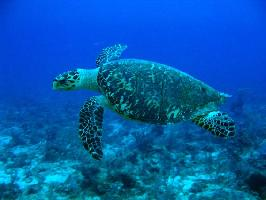
Váhy a míry
| Délka | 150 cm |
|---|---|
| Hmotnost | 180 kg |
Biologická data
| Délka života | False |
|---|
Popis zvířete
The Green Sea Turtle (Chelonia mydas), often simply referred to as the green turtle, is a large, graceful marine reptile belonging to the family Cheloniidae. This species is one of the largest sea turtles and a distinguished member of the marine ecosystem, playing a crucial role in maintaining the health of seagrass beds and coral reefs. With its broad, smooth carapace and a palette of colors that range from olive to black, this turtle is a marvel of the oceanic world.Adult green sea turtles exhibit a unique herbivorous diet, primarily grazing on seagrasses and algae, which influences their green-colored fat, hence the name "green" sea turtle. This dietary preference is vital for the ecosystem, as their grazing helps maintain the health and growth of seagrass beds, which are important breeding and developmental grounds for many marine species.
Physically, the green sea turtle is a striking creature. It possesses a heart-shaped carapace that can grow up to 1.5 meters (5 feet) in length and weigh up to 300 kilograms (660 pounds), making it one of the larger species of sea turtles. Unlike land turtles, the green sea turtle cannot retract its head or limbs under its shell. Its limbs are shaped like flippers, adaptations that make it an excellent swimmer, capable of traversing thousands of kilometers across oceans.
The coloration of the green sea turtle's shell, or carapace, can vary widely among individuals and by region, from shades of black, grey, green, brown, and sometimes a mix that results in a marbled appearance. The carapace is smooth, without ridges, and the underside, or plastron, is light-colored. The turtle's skin ranges from green to black with white, yellow, or green markings.
Green sea turtles have a complex life cycle that begins with females laying eggs on sandy beaches, often on the very beaches where they were born. After incubation periods of about 60 days, hatchlings emerge and make their perilous journey to the sea, facing numerous predators along the way. Those that survive mature in the open ocean, where they live solitary lives until they reach sexual maturity. Mature turtles then migrate, sometimes over thousands of kilometers, to breeding grounds where they mate, and females return to beaches to lay their eggs, thus continuing the cycle.
Despite their beauty and ecological importance, green sea turtles face significant threats from human activities. These include habitat loss due to coastal development, pollution, accidental capture in fishing gear, poaching for their eggs, meat, and shells, and climate change, which affects their nesting beaches and sex ratio of hatchlings. As a result, the green sea turtle is listed as Endangered on the IUCN Red List of Threatened Species, and numerous conservation efforts are underway globally to protect and preserve this magnificent marine creature and its habitat for future generations.
Podobná zvířata
Nové fotografie zvířat
Top 10 zvířat
- Dolphin gull (Leucophaeus scoresbii)
- Diana monkey (Cercopithecus diana)
- Stone loach (Barbatula barbatula)
- Greek tortoise (Testudo graeca)
- Japanese macaque (Macaca fuscata)
- Moustached guenon (Cercopithecus cephus)
- Galápagos tortoise (Geochelone nigra complex)
- Russian tortoise (Testudo horsfieldii)
- Galápagos penguin (Spheniscus mendiculus)
- Common flying dragon (Draco volans)

